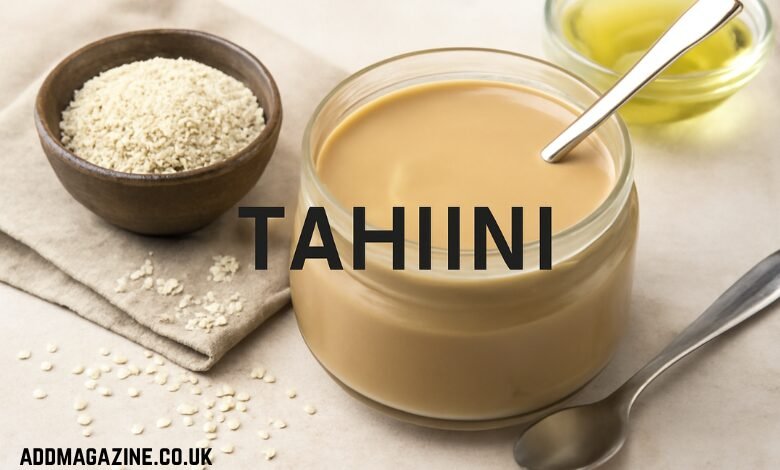Tahini, a paste made from ground sesame seeds, has been a culinary staple for centuries. However, many people mistakenly write it as “tahhiini,” adding an extra “i” to the name, leading to confusion. While “tahhiini” may sound like a different food, it essentially refers to the same thing—tahini. This blog will explore tahini in detail, examining what it is, how it’s made, its benefits, and why it’s such a popular ingredient in cooking.
What is Tahini?
Tahini is a velvety paste created by transforming sesame seeds into a creamy, smooth texture. It’s an essential ingredient in Middle Eastern and Mediterranean cuisines, often used in dishes like hummus, baba ganoush, and salad dressings. It has a nutty flavor and a rich texture, making it versatile enough for both savory and sweet recipes.
The Origins of Tahini
Tahini’s origins can be traced back thousands of years to the ancient civilizations of the Middle East. While the exact country of origin is debated, it is widely believed to have originated in regions such as present-day Lebanon, Syria, or Egypt. It has since spread across various cultures, becoming a staple in the diets of many countries due to its versatility and health benefits.
How is Tahini Made?
Tahini is made by grinding sesame seeds, which are typically toasted to enhance their flavor. The process involves:
- Roasting the Sesame Seeds: Sesame seeds are first roasted to develop a deeper flavor. Raw sesame seeds can be used, but toasting them intensifies the nutty taste.
- Grinding: The roasted seeds are ground into a smooth paste. Some variations include the addition of oil (usually sesame oil) to make the paste creamier.
- Storage: Once prepared, tahini is stored in jars or containers, where it can be kept for an extended period without spoiling.
Ingredients and Steps to Make Tahini at Home
The process of making tahini at home is simple, requiring just a few ingredients:
Ingredients:
- Sesame Seeds: The main ingredient. You can choose from either white or black sesame seeds for making tahini.
- Oil: A neutral oil like vegetable oil or sesame oil can be added to achieve a smoother consistency.
- Salt: Optional, for flavor.
Steps:
- Toast the Sesame Seeds (optional, but recommended for enhanced flavor).
- Grind the Seeds: Blend sesame seeds in a processor or blender until they achieve a silky, consistent texture. Add oil to reach the desired consistency.
- Store: Once the tahini is smooth and creamy, transfer it to a sealed container.
Why Was Tahini Made?
Tahini was created to make sesame seeds more accessible and easier to consume. Raw sesame seeds can be hard to eat in large quantities, but when ground into a paste, they can be added to various dishes and easily digested. The process also preserves the nutritional value of sesame seeds, making them more versatile in different types of cooking.
Benefits of Tahini
Tahini isn’t just popular for its taste; it’s also packed with numerous health benefits:
- Rich in Healthy Fats: Tahini is a great source of unsaturated fats, which can help lower bad cholesterol levels and promote heart health.
- High in Protein: Sesame seeds, the main ingredient in tahini, provide a plant-based protein source that can be valuable for vegetarians and vegans.
- Packed with Vitamins and Minerals: Tahini contains essential vitamins such as B vitamins (including B1, B2, and B6), as well as minerals like magnesium, iron, and calcium.
- Antioxidant Properties: Sesame seeds are rich in antioxidants that help protect the body from free radical damage and reduce inflammation.
- Promotes Healthy Skin: The vitamin E content in tahini can contribute to healthier skin, protecting it from signs of aging and environmental damage.
Disadvantages of Tahini
While tahini is incredibly healthy, there are a few considerations:
- High in Calories: Since it’s made from sesame seeds and oil, tahini is calorie-dense. Consuming it in moderation is key, especially for those watching their calorie intake.
- May Contain Additives: Some commercial tahini brands may contain additives, preservatives, or excess salt. It’s always advisable to check the label or opt for homemade tahini.
- Potential Allergens: Sesame is a common allergen, so people with sesame allergies should avoid tahini altogether.
Why Is Tahini So Popular?
Tahini has gained widespread popularity for several reasons:
- Versatility: It can be used in both savory and sweet dishes, making it adaptable to many different cuisines.
- Nutritional Value: With its wealth of health benefits, tahini is often seen as a superfood. It’s particularly popular in vegan and vegetarian diets as a source of protein and healthy fats.
- Cultural Significance: As a staple in Middle Eastern and Mediterranean cuisines, tahini has cultural significance and is often associated with traditional dishes like hummus, falafel, and shawarma.
Nutritional Benefits of Tahini
Tahini is packed with essential nutrients. Here’s a look at its nutritional profile per 2-tablespoon (about 30 grams) serving:
- Calories: 180-200 kcal
- Protein: 5-6 grams
- Fat: 16 grams (mainly unsaturated fats)
- Carbohydrates: 6-7 grams
- Fiber: 2-3 grams
- Calcium: 8-10% of the daily recommended intake
- Iron: 10-12% of the daily recommended intake
- Magnesium: 8% of the daily recommended intake
Uses of Tahini in Different Dishes
Tahini is incredibly versatile, being used in a variety of dishes, both savory and sweet. Here are several tasty methods to incorporate tahini into your meals:
Savory Dishes:
- Hummus: The most famous use of tahini is in hummus, where it adds creaminess and a rich, nutty flavor.
- Baba Ganoush: Another Middle Eastern classic, baba ganoush is a smoky eggplant dip that often contains tahini for creaminess.
- Salad Dressings: Mix tahini with lemon juice, garlic, and water to create a creamy dressing for salads.
- Shawarma and Falafel: Tahini is often drizzled over shawarma or used as a dipping sauce for falafel.
- Tahini dressing: A simple blend of tahini, water, garlic, lemon juice, and salt, perfect for drizzling over roasted vegetables or meats.
Sweet Dishes:
- Tahini Desserts: In some Middle Eastern desserts, tahini is combined with honey or sugar to create sweet treats.
- Tahini Chocolate Spread: Mixing tahini with cocoa and sweeteners can create a rich, healthy chocolate spread.
- Smoothies: Add a spoonful of tahini to your smoothie for extra creaminess and a boost of nutrients.
Variations of Tahini
There are several variations of tahini, depending on the type of sesame seeds used and the method of preparation:
- White Tahini: Made from hulled sesame seeds (seeds with their shells removed), resulting in a smoother, lighter-colored paste.
- Black Tahini: Made from unhulled sesame seeds (seeds with their shells intact), which gives the tahini a darker color and a slightly bitter taste. This variety is considered more nutritious due to the presence of the sesame seed’s outer hull.
Using Tahini in a Diet
Tahini can be a valuable addition to a healthy diet when consumed in moderation. Its high protein and healthy fat content make it an excellent choice for those looking for a plant-based protein source. The antioxidants and anti-inflammatory properties of tahini also contribute to overall health.
Tahini in Vegan and Vegetarian Diets
For vegans and vegetarians, tahini is an important ingredient as it provides a plant-based source of calcium, iron, and protein. It’s an excellent addition to many vegan dishes, helping to meet the nutritional needs of those who do not consume animal products.
Tahini in Low-Carb and Keto Diets
Tahini is also suitable for low-carb and keto diets due to its high fat and low carbohydrate content. It can be used as a dip for low-carb vegetables or added to smoothies to increase the fat content.
Recipes to Try with Tahini
Here are some favorite recipes that highlight the full potential of tahini:
- Classic Hummus: Blend chickpeas, tahini, lemon juice, garlic, olive oil, and salt to create this smooth, creamy dip.
- Tahini Salad Dressing: Combine tahini, olive oil, lemon juice, and garlic for a creamy and tangy dressing.
- Tahini Smoothie: Blend tahini, banana, spinach, almond milk, and a bit of honey for a nutritious and creamy smoothie.
Conclusion
Tahini is more than just a paste—it’s a powerhouse of nutrients that can be used in various dishes, both savory and sweet. Whether you’re looking to add some richness to your hummus or use it in a dessert, tahini is a versatile ingredient with numerous health benefits. With its long history and broad range of applications, tahini is likely to remain a favorite in kitchens around the world for years to come.




